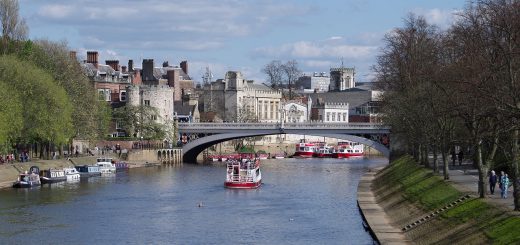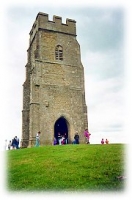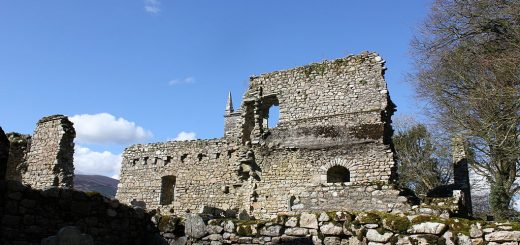Rochdale Rush-Bearing
As far as I am aware Rochdale no longer celebrates the Rush Bearing festival, though nearby Littleborough revived theirs in 1991 and continue to celebrate it each year. Below is description of how Rochdale and its Rush-Bearing from Lancashire Legends (1873) by John Harland & T T Wilkinson.
The annual ceremony of rush-bearing is celebrated in Rochdale and in many other parishes in Lancashire. This custom, partaking of the nature of a village-wake, is of high antiquity, probably as remote as the age of Pope Gregory IV. (a.d. 827), who, on the introduction of Christianity into this country, recommended to Melletus, the coadjutor of St Augustine, that on the anniversary of the dedication of the Christian churches wrested from the pagans, the converts to Christianity should “build themselves huts of the boughs of trees about their churches, and celebrate the solemnities with religious feastings.” On a fixed day in every year — in Rochdale on the 19th August — a kind of obtuse pyramid of rushes, erected on a cart, is highly ornamented in front, and surmounted by a splendid garland. To the vehicle so laden, from thirty to forty young men, wearing white jackets and ornamented with ribbons and flowers, are harnessed in pairs. A band of music is always in attendance, which strikes up on the cart moving on, and thousands of spectators, attracted from a distance of ten or even twenty miles around, hail with repeated cheers the showy pageant. The procession then advances to the town, and, on arriving in front of each of the inns, a kind of morrice-dance is performed by the men in harness, who jingle copper bells, and beat or rather stamp tune with their wooden shoes — the clown, who is dressed in female attire, all the while collecting money to refresh the actors in the grotesque exhibition. From the town,, the procession passes to the neighbouring mansions, where the dance is again repeated, and where the performers are presented by the ladies with garlands and money. Till about the early part of the nineteenth century the rush-bearing usually terminated at the church, and the rushes were spread on the clay floor under the benches used as seats by the congregation, to serve as a winter carpet ; while the garlands were hung up in the chancel and over the pews of the families by whom they had been presented, where they remained till their beauty had faded. But within the last half century the church is frequently the last place thought of in this festival, which has degenerated into mere rustic saturnalia. Formerly not fewer than a dozen of these processions from different parts of the parish entered Rochdale on the annual celebration ; but they have now (1832) dwindled down to three or four, and are gradually dying away. This is in accordance with what Baines says in his “Lancashire,” but a correspondent of Hone’s “Year Book,” signing “J. L.” and dating from Rochdale, May 31, 1825, gives the following account of the custom of rush-bearing in that neighbourhood, illustrated by a woodcut (col. x. 1 103). A few years ago, I was told by an old man now deceased, that he remembered the rushes to have been borne on the shoulders of the country people in bundles, some very plain and others ornamented with ribbons, garlands, &c., to the churchyard in Rochdale; that they were there dried previous to being put into the church, and that these rush-bearers received a small compensation from the churchwardens. This was before churches were floored with wood. The rushes were strewed for the purpose of rendering the congregation more comfortable, and saving •their feet from being chilled by the stone pavements, and, in some instances, the clay floors. In many churches rushes are used in the same manner in the present day; but the old, homely method of rush-bearing on the shoulders has given place to the more luxurious and gorgeous display of the rush-cart and banner. The rushes are laid transversely on the rush-cart, and are cut by sharp knives to the form desired, in which no little art is required. The bolts, as they are termed, are formed of the largest rushes tied up in bundles of about two inches in diameter. These bolts, as the work of making proceeds, are afiixed to rods fixed in the four corners of the cart, and carved to the form required. When the cart is finished, the load of rushes is decorated with carnations and other flowers, in different devices, and surmounted by branches of oak, and a person rides upon the top. The carts are sometimes drawn by horses gaily caparisoned, but more frequently by young men, to the number of twenty or thirty couples, profusely adorned with ribbons, tinsel, &c. They were generally preceded by men with horse-bells about them, grotesquely jumping from side to side, and jingling the bells. After these is a band of music, and sometimes a set of morris-dancers (but without the ancient appendage of bells) followed by young women bearing garlands; then comes the banner, made of silk of various colours, joined by narrow ribbon fretted, the whole profusely covered on both sides with roses, stars, &c., of tinsel (which in this part is called horse-gold), and which being viewed when the sun shines upon it, dazzles the eye.
The banners are generally from four to five yards broad and six to eight yards long, having on either side in the centre a painting of Britannia, the king’s arms, or some other device. The whole procession is flanked by men with long cart-whips, which they keep continually cracking to make a clear path On the front of some carts is a white cloth, to which is attached a number of silver spoons, tankards, cups, and watches, tastefully displayed. Great rivalry exists between the young men of the neighbouring villages which should produce the best-formed cart and banner, and it not unfrequently happens that when two of them meet in the street, a scuffle takes place and many bloody noses are the result. Six or seven rush-carts are frequently in the town of Rochdale on the third Monday in August, which is the day for strewing them. A collection is made by each party from the gentry and other inhabitants, which enables the rush-bearers to sacrifice very freely at the shrine of Sir John Barleycorn. The displays are very gay, and afford much gratification to a stranger who never before witnessed a rush-bearing. The practice is ‘general in the months of July, August, and September, Those held round this place are at Ashworth, Littleborough, Milnrow, Shaw, Oldham, Royton, Middleton, Heywood, and Whitworth ; the customs at each place being much alike. The person who has the forming of a rush-cart is called a featherer, and it was one of these men who unfortunately lost his life at the riots in this town on Easter Monday in April 1794 or 1795. He resided at Mereland, and for a number of years afterwards, in commemoration of his death, the young men who drew the rush-cart from Mereland wore a black scarf, but it is now discontinued. The author of “Scarsdale” has given a graphic account of rush-bearings as they were celebrated fifty years ago. He says : — On the bowling-green behind the house a booth had been built with ribs of timber covered with canvas, and a floor of rough boards to protect the smooth sward. Here, to the accompaniment of a couple of fiddles, flageolets and a fife, about fifty couple were in the full excitement of a country-dance, while many country lads and lasses were looking on. Through the garden behind the green wandered other groups. In front of the inn stood the rush-cart, which to our southern readers may require a more detailed description. One of the larger carts used in Lancashire either to carry manufactured goods or to bring harvest from the field had been heaped with rushes to the height of about twenty-four feet from the ground. The rushes were skilfully arranged into a perfectly smooth conical stack, rising to a sharp ridge at the top. From this centre four hedges, formed of rushes woven into a neat pattern, and each hedge about two feet high, descended to the four corners of the cart. On the summit was a bower in the form of a crown, made of holly, laurel, and other evergreens, round which were twined garlands. An immense wreath of large flowers encircled the base of the arbour, and a smaller one decorated its top. On each of the smooth sides of the cone, between the boundary of rush-hedges, were inscriptions in brilliantly coloured flowers, such as “Colliers and Weavers,” “Fear God,” “Honour the King,” &c. Spangled flags of various bright hues hung from the sides of the crowning bower. A large silver salver from the Hall, with some silver tankards, hung on the front. About thirty young men, with white shirts down to the waist, profusely adorned with gay ribbons, and with wreaths of flowers on their heads, were yoked in couples between two strong new ropes. Each couple held a stave fastened on either side into a knot in the rope, and they were engaged in practising some dances, with which their entry into the principal streets of Rochdale was to be celebrated. A strong horse was in the shafts, and behind was a band of other gaily-dressed young men, similarly yoked between ropes, to hold the cart while descending any steep hill. A bugle sounded to summon the dancers from the booth, the revellers from the club-room, and the wandering groups and whispering lovers from the garden. Some miles of road had to be traversed, and all the rush-carts from the neighbouring villages were to meet in Rochdale at noon. There issued from behind the house the whole united band, with a big drum, two bugles, two trumpets, several other brass instruments, with fifes, flageolets, &c. They were the heralds of an immense banner, held in the air by four men, two on each side, who grasped long slender poles supporting a transverse piece, from which swung this mighty achievement of the art of Scarsdale. In the centre were the Scarsdale arms, which had never been so fiercely emblazoned before ; on the top was a view of Scarsdale Hall, painted on paper mounted on cloth. There were masonic devices, emblematic monsters, wonderfully shaped spangles, roses, wreaths, and other caprices of the imagination of the Scarsdale artists. The result was one of barbaric splendour of colour and tinsel. This marvellous pomp was heralded by a deafening clamour of the band, which did its worst against rival sounds, even almost drowning the frantic shouts with which the phenomenon of the banner was greeted. Seth Diggle had been promoted to the post of honour on the top of the cart, where he held a banner on which the Scarsdale arms were emblazoned on the Union Jack. Before the cart started for Rochdale, however, a country-dance was formed on each side of the road, it being the privilege of the young men yoked in the cart to choose their partners from the prettiest country girls — nothing loath for such a distinction. The band struck up loudly, the banners stood grandly at one end of the two sets of thirty couples, and at the other the cart, with Seth in the bower at its crown. Half-an-hour was devoted to this dance, when the bugle again sounded, the dance at once ceased, the young men kissed their partners and took their places, and, amidst the shouts of the crowd, and the wildest efibrts of the band, the Scarsdale rush-cart started for Rochdale. About the same time a similar fete was in progress at Hurstwood, at Martinmere, at Eastleton, at Milnrow, at Smallbridge, at Whitworth, at Spotland and other villages; for it was the glory of Rochdale to assemble at its rush-bearing, forty years ago, at least eight, and sometimes a dozen, rush-carts from the neighbouring villages. Meanwhile, the gala of the rush-bearing was in the delirium of its frenzy, the rush-carts having assembled in the street opposite the Butts, each with its band in front, the order of procession extending over the bridge across the Roche, and a considerable distance up Yorkshire Street. Every band played with stentorian energy, ” Rule Britannia ; ” the young men drawing every cart vied with each other in the vigour and picturesque character of their dances; the flags in every bower on the top of the rush-carts were waved triumphantly; the spangled and decorated banners carried before each band glittered in the bright noon ; from every window hung flags or coloured dr9,peries, handkerchiefs were waved, and loud huzzas broke to swell the exulting torrent of acclamation. The main thoroughfares were crowded by a multitude of folk in their gayest dresses; in side-streets were stalls with Eccles cakes, Everton toflfy, and Ormskirk gingerbread; and booths with shows of every kind frequenting a country fair. Conjurors stood on their stages, watching for the passage of the procession to attract a crowd of gazers by their wonderful tricks. Mountebanks and clowns were ready to perform, when the streets were clear from the grand pageant of the day. There was a bear on the Butts growling defiance at the dogs by which it was to be baited, and climbing at intervals to the top of the high stake to which he was chained. Then a pilot balloon of gay colours floated gracefully from a garden of the ” Orchard,” near the river, and the roar of guns boomed on the ear at short intervals as the pretty phantom rose in the still air to a great height, and then floated away in the tide of an upper current. When the twenty-first gun had been fired, the procession commenced its progress through the town, amidst the wildest shouts and gestures from the crowd. Yorkshire Street, especially at its steepest and most tortuous part, in the heart of the town, consisted five-and-thirty years ago either of quaint stone houses with muUioned windows, gothic doors, and peaked gables, or of white-and -black timber-houses projecting over first a low-browed shop, then with an overhanging story, containing often a wooden oriel, and higher a gabled story, whose bolder projection invaded the upper area of the street. Smithy Door, and Old Millgate, and other streets in the neighbourhood of the Collegiate Church of Manchester, half a century ago, consisted mainly of such structures, which have now to a great extent disappeared. Chester still abounds with them in a picturesque form. In this narrow and tortuous lane of ancient houses, the procession of rush-carts almost brushed the projecting gables. The men on the crown of each cart were covered with flowers flung by fair hands from the highest windows, just too far off to be reached by a friendly grasp. Overhead, webs of coloured flannel and calico stretched across from the peaks of opposite roofs, but little above the flagstaff of each crown. There was barely room for the great banners to pass. Every window was decorated and crowded. The bray of the bands resounded in the narrow steep street. There was a confusion of gay colours, an agitation of bright forms, a tumult of rude joy, the transient frenzy of a carnival, as each long train of white-shirted ribbon-covered men dragged its cart up the hill, pausing and dancing at intervals amidst the exultation of the crowd.





Recent Comments